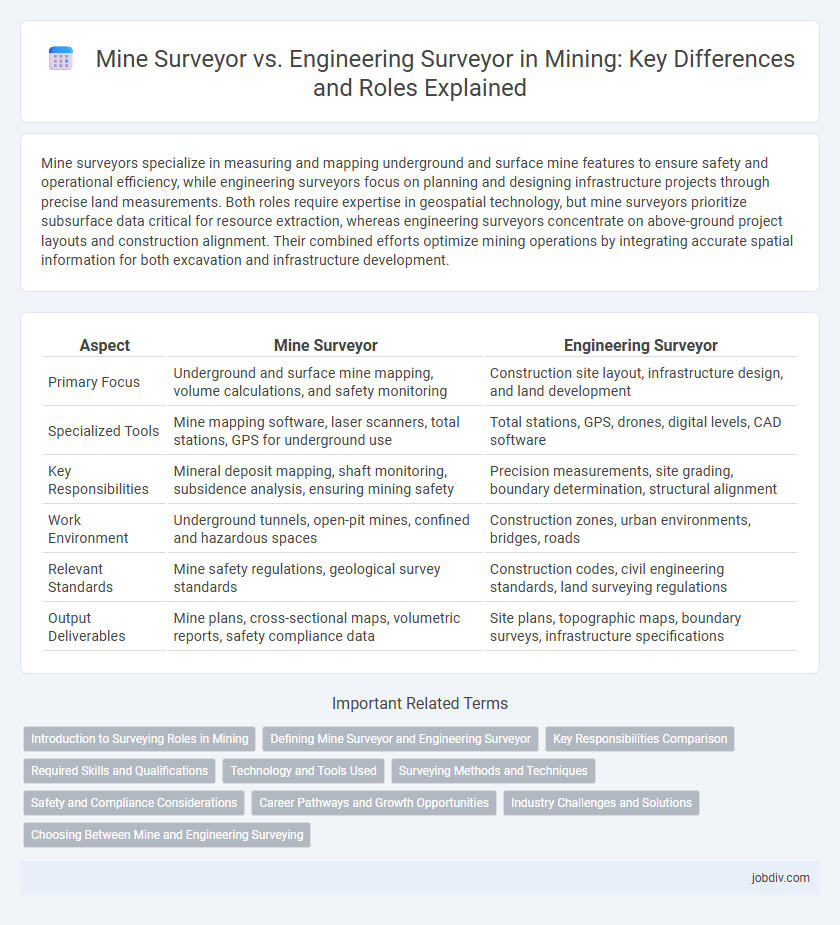Mine surveyors specialize in measuring and mapping underground and surface mine features to ensure safety and operational efficiency, while engineering surveyors focus on planning and designing infrastructure projects through precise land measurements. Both roles require expertise in geospatial technology, but mine surveyors prioritize subsurface data critical for resource extraction, whereas engineering surveyors concentrate on above-ground project layouts and construction alignment. Their combined efforts optimize mining operations by integrating accurate spatial information for both excavation and infrastructure development.
Table of Comparison
| Aspect | Mine Surveyor | Engineering Surveyor |
|---|---|---|
| Primary Focus | Underground and surface mine mapping, volume calculations, and safety monitoring | Construction site layout, infrastructure design, and land development |
| Specialized Tools | Mine mapping software, laser scanners, total stations, GPS for underground use | Total stations, GPS, drones, digital levels, CAD software |
| Key Responsibilities | Mineral deposit mapping, shaft monitoring, subsidence analysis, ensuring mining safety | Precision measurements, site grading, boundary determination, structural alignment |
| Work Environment | Underground tunnels, open-pit mines, confined and hazardous spaces | Construction zones, urban environments, bridges, roads |
| Relevant Standards | Mine safety regulations, geological survey standards | Construction codes, civil engineering standards, land surveying regulations |
| Output Deliverables | Mine plans, cross-sectional maps, volumetric reports, safety compliance data | Site plans, topographic maps, boundary surveys, infrastructure specifications |
Introduction to Surveying Roles in Mining
Mine surveyors specialize in mapping underground and surface mining operations, ensuring accurate measurements for excavation and safety compliance. Engineering surveyors focus on infrastructure projects, providing precise data for construction and maintenance of mining facilities. Both roles are critical for optimizing mining efficiency and minimizing operational risks through accurate spatial data collection.
Defining Mine Surveyor and Engineering Surveyor
A Mine Surveyor specializes in mapping underground and surface mine layouts to ensure accurate resource extraction and site safety, utilizing advanced surveying technologies like GPS and laser scanning. An Engineering Surveyor focuses on establishing precise measurements for construction projects, including infrastructure and site development essential to mining operations. Both roles require expertise in geospatial data analysis, but the Mine Surveyor is specifically trained to address challenges unique to mining environments.
Key Responsibilities Comparison
Mine surveyors specialize in mapping underground mine layouts, monitoring excavation progress, and ensuring safe mine operations through precise spatial data collection. Engineering surveyors focus on land measurement, construction layout, and infrastructure design, providing essential topographic and structural data for mining projects. Both roles require expertise in surveying instruments and geo-spatial analysis but differ in their scope, with mine surveyors concentrated underground and engineering surveyors handling surface and structural surveys.
Required Skills and Qualifications
Mine surveyors require expertise in geospatial data analysis, underground and surface surveying techniques, and proficiency in mining-specific software like AutoCAD and MineSight. Engineering surveyors must possess strong knowledge of civil engineering principles, construction methods, and precise measurement skills using total stations and GPS technology. Both roles demand a degree in surveying or geomatics, but mine surveyors often need additional training in mining regulations and safety standards.
Technology and Tools Used
Mine surveyors employ specialized geospatial technologies such as total stations, laser scanning, and GNSS systems to map underground and surface mining sites with high precision. Engineering surveyors utilize advanced tools like digital theodolites, 3D modeling software, and automated data collection systems to support the design and construction of mine infrastructure. Both roles integrate geographic information systems (GIS) and remote sensing to enhance accuracy and efficiency in mining project planning and execution.
Surveying Methods and Techniques
Mine surveyors employ specialized underground mapping, laser scanning, and geospatial data integration to accurately measure mine tunnels, shafts, and ore bodies, ensuring safe and efficient excavation. Engineering surveyors focus on a broader range of techniques, including GPS, total stations, and leveling instruments, to support infrastructure development and construction projects with precise topographic and structural data. Both roles rely on advanced surveying software and geographic information systems (GIS) to analyze spatial information, but mine surveyors prioritize subsurface environments while engineering surveyors emphasize surface and structural surveys.
Safety and Compliance Considerations
Mine surveyors specialize in mapping underground and surface mine environments to ensure accurate spatial data essential for safe mining operations, enforcing strict compliance with mining regulations. Engineering surveyors focus on infrastructure measurements and construction alignment, ensuring that projects meet safety standards and regulatory requirements to prevent structural failures. Both roles are critical for maintaining safety protocols and regulatory adherence, reducing risks associated with mining operations.
Career Pathways and Growth Opportunities
Mine Surveyors specialize in mapping and measuring underground mine structures, ensuring accurate data for mining operations, with career growth leading to roles such as Chief Mine Surveyor or Geomatics Manager. Engineering Surveyors focus on infrastructure projects including roads, bridges, and buildings, offering pathways toward Senior Engineering Surveyor or Project Survey Manager positions. Both careers demand strong technical skills, but Mine Surveyors often advance within the mining industry, while Engineering Surveyors have broader opportunities in construction, civil engineering, and urban development sectors.
Industry Challenges and Solutions
Mine surveyors specialize in mapping underground and surface mine features, addressing challenges like complex terrain and constantly changing excavation boundaries. Engineering surveyors focus on infrastructure projects, tackling issues related to precision measurements for construction and alignment in rugged environments. Advanced GNSS technology and drone-based remote sensing provide precise data solutions, improving accuracy and safety in both mining and engineering surveying tasks.
Choosing Between Mine and Engineering Surveying
Choosing between mine surveying and engineering surveying depends on project scope and environment, where mine surveyors specialize in underground and surface mining measurements to ensure safety and resource estimation. Engineering surveyors focus on construction projects, providing precise topographic data and layout control for infrastructure development. Understanding project requirements and survey methods is crucial for selecting the appropriate surveying discipline.
Mine Surveyor vs Engineering Surveyor Infographic

 jobdiv.com
jobdiv.com